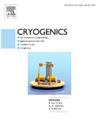Investigation on surface insulating performance of epoxy-alumina and epoxy-zinc oxide nanocomposites at cryogenic temperatures
IF 2.1
3区 工程技术
Q3 PHYSICS, APPLIED
引用次数: 0
Abstract
The electrical insulation properties of epoxy resin at low temperatures are crucial for the encapsulation of superconducting magnets. Nanoparticle filling serves as an effective approach to enhance the electrical insulation performance of epoxy resin. This paper comparatively investigates the surface insulating properties of epoxy-alumina (Al2O3/EP) and epoxy-zinc oxide (ZnO/EP) nanocomposites at cryogenic temperatures from 10 K to 299 K. The addition of nanofillers introduces more traps in the epoxy nanocomposites, which makes the time scales of the above-surface and sub-surface processes coincide with each other when the temperature is further reduced (lower than 80 K), resulting in a downward trend in the flashover voltage of the epoxy nanocomposite when the temperature is further reduced. Experimental results demonstrate that Al2O3 nanofillers can improve the surface insulation performance of the nanocomposite more comprehensively than ZnO nanofillers. Al2O3/EP has a higher flashover strength than neat epoxy, regardless of temperature.
环氧-氧化铝和环氧-氧化锌纳米复合材料的低温表面绝缘性能研究
环氧树脂在低温下的电绝缘性能对超导磁体的封装至关重要。纳米颗粒填充是提高环氧树脂电绝缘性能的有效途径。对比研究了环氧氧化铝(Al2O3/EP)和环氧氧化锌(ZnO/EP)纳米复合材料在10 ~ 299 K低温下的表面绝缘性能。纳米填料的加入使环氧纳米复合材料中引入了更多的陷阱,当温度进一步降低(低于80 K)时,使环氧纳米复合材料的表面上和表面下过程的时间尺度重合,导致环氧纳米复合材料的闪络电压在温度进一步降低时呈下降趋势。实验结果表明,Al2O3纳米填料比ZnO纳米填料能更全面地改善纳米复合材料的表面绝缘性能。无论温度如何,Al2O3/EP均比纯环氧树脂具有更高的闪络强度。
本文章由计算机程序翻译,如有差异,请以英文原文为准。
求助全文
约1分钟内获得全文
求助全文
来源期刊

Cryogenics
物理-热力学
CiteScore
3.80
自引率
9.50%
发文量
0
审稿时长
2.1 months
期刊介绍:
Cryogenics is the world''s leading journal focusing on all aspects of cryoengineering and cryogenics. Papers published in Cryogenics cover a wide variety of subjects in low temperature engineering and research. Among the areas covered are:
- Applications of superconductivity: magnets, electronics, devices
- Superconductors and their properties
- Properties of materials: metals, alloys, composites, polymers, insulations
- New applications of cryogenic technology to processes, devices, machinery
- Refrigeration and liquefaction technology
- Thermodynamics
- Fluid properties and fluid mechanics
- Heat transfer
- Thermometry and measurement science
- Cryogenics in medicine
- Cryoelectronics
 求助内容:
求助内容: 应助结果提醒方式:
应助结果提醒方式:


